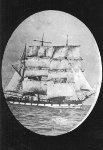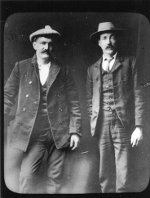

Brier Holme
 Brier
Holme, 894 NRT, a clipper-barque, built by J.L. Thompson, Sunderland,
in 1876 with the following dimensions: length 206.1 ft; breadth 33.6
ft; depth 19.0 ft. Delivered to Hine Bros in 1877 and registered with
the managing owner, Wildrid Hine, Custom House Buildings, Maryport.
Like several other ships belonging to this firm, she was engaged in the
Tasmanian wool trade and soon became on of its best-known vessels. All
the Holme Line ships were noted not only for their smart appearance and
for being well run, but for their speed, usually taking only 80 days on
the outward passage and round about 90 days on the homeward run.
Brier
Holme, 894 NRT, a clipper-barque, built by J.L. Thompson, Sunderland,
in 1876 with the following dimensions: length 206.1 ft; breadth 33.6
ft; depth 19.0 ft. Delivered to Hine Bros in 1877 and registered with
the managing owner, Wildrid Hine, Custom House Buildings, Maryport.
Like several other ships belonging to this firm, she was engaged in the
Tasmanian wool trade and soon became on of its best-known vessels. All
the Holme Line ships were noted not only for their smart appearance and
for being well run, but for their speed, usually taking only 80 days on
the outward passage and round about 90 days on the homeward run.
On 21 July 1904 she sailed from London with a crew of 18 under the command of Captain John H. Rich, who at that time resided in Church Street, Maryport, having previously lived at 6 North Street. This vessel was judged to be an outstanding example of her type, for a model of the Brier Holme had won a prize at the Paris Exhibition. Her master was a captain of long experience and this was his last voyage before retirement. No-one anticipated the tragedy which was to come.
Bound
for Tasmanian ports with a cargo of London mixed, the ship's passage
had been slowed by adverse winds until she rounded the Cape of Good
Hope, after which she made good progress. When, 107 days out of London,
off Western Tasmania she ran into heavy weather with mountainous seas,
the ship hove to, but just before midnight on 5 November 1904 the Brier
Holme was driven onto the rocks at Elliott's Cave. As soon
as the
vessel struck, the dynamite, which formed part of her cargo, exploded,
and it was thought that the captain and some of the crew were killed
immediately. The rest climbed onto the rigging, because the lifeboats
had been carried away, but when the ship broke up and the masts went,
they were all drowned, except one, Oscar Larsen (who was Danish). He
was thrown into the
water and knocked about by the waves, eventually to be swept up on the
beach where, though bleeding and almost exhausted, he managed to crawl
away from the dangerous waters.
 At
daybreak on 6 November, Larsen was able to cast a weather eye around to
discover if any other crew members had been saved, but he could find
on-one. Weighing up his prospects of
survival, the sailor deduced that
the Brier Holme had been so near to its western coast he must now be on
the Tasmanian mainland, so there was a good chance of his being
rescued. When the seas abated he went to the wreck and found himself a
plentiful supply of food from amongst the cargo. On several different
occasions Larsen set off inland to try and reach the nearest
habitation, but the terrain was so rough that he was forced to return
to the shore.
At
daybreak on 6 November, Larsen was able to cast a weather eye around to
discover if any other crew members had been saved, but he could find
on-one. Weighing up his prospects of
survival, the sailor deduced that
the Brier Holme had been so near to its western coast he must now be on
the Tasmanian mainland, so there was a good chance of his being
rescued. When the seas abated he went to the wreck and found himself a
plentiful supply of food from amongst the cargo. On several different
occasions Larsen set off inland to try and reach the nearest
habitation, but the terrain was so rough that he was forced to return
to the shore.
Meanwhile,
when the Brier Holme
became overdue at her first port of call,
considerable anxiety was aroused. As the weeks turned into months and
there was still no news of any kind, those experienced in such matters
had to admit that it was futile to hope any longer. The Brier Holme was
posted missing at Lloyds on 18 January 1905. After pressure had been
brought to bear, the Tasmanian government dispatched two coastwise
expeditions to search for survivors without success. It transpired
later that these visits must have coincided with Larsen's excursions
inland. In late January, reports came into Hobart of wreckage
identified as belonging to the Brier
Holme being found on the south
west coast of the island.
 Able
Seaman Larsen had been a solitary castaway for over three
months, by
which time he had become extremely despondent. On 13 February to his
joy he observed a small craft approaching the shore and waved to
attract the sailors' attention. At first the seamen could hardly
believe what was happening until the boat came in closer and the
fishermen spoke to him and helped him on board their fishing boat Britannia,
which was operating off Port Davy. Then he told them his story and they
set sail for Hobart immediately, which was a distance of approximately
150 miles. On the way they were overhauled by a steamer and passed on
the news of the rescue to her captain, who as soon as his ship docked
in Hobart made it known publicly. As a result, large crowds were
waiting to welcome the Britannia
and her passenger, the sole survivor of the wrecked Brier Holme, whose
story of her last hours and his fight for life was listened to with
great attention. Larsen is pictured here with Edward Noye [on the right], the skipper of
the Britannia. (Our thanks to Jonothan Davies of
Hobart, Tasmania for some of this information.)
Able
Seaman Larsen had been a solitary castaway for over three
months, by
which time he had become extremely despondent. On 13 February to his
joy he observed a small craft approaching the shore and waved to
attract the sailors' attention. At first the seamen could hardly
believe what was happening until the boat came in closer and the
fishermen spoke to him and helped him on board their fishing boat Britannia,
which was operating off Port Davy. Then he told them his story and they
set sail for Hobart immediately, which was a distance of approximately
150 miles. On the way they were overhauled by a steamer and passed on
the news of the rescue to her captain, who as soon as his ship docked
in Hobart made it known publicly. As a result, large crowds were
waiting to welcome the Britannia
and her passenger, the sole survivor of the wrecked Brier Holme, whose
story of her last hours and his fight for life was listened to with
great attention. Larsen is pictured here with Edward Noye [on the right], the skipper of
the Britannia. (Our thanks to Jonothan Davies of
Hobart, Tasmania for some of this information.)
 The
news was telegraphed by the firm of William Crosby, shipping agents in
Hobart, to Brier Holme's
owners, Hine Bros at Maryport, and
then became generally known. So those who had been waiting, keeping
faint hopes for their loved ones' safety alive, became aware of the
facts of the tragedy. There were many sad homes in the town.
The
news was telegraphed by the firm of William Crosby, shipping agents in
Hobart, to Brier Holme's
owners, Hine Bros at Maryport, and
then became generally known. So those who had been waiting, keeping
faint hopes for their loved ones' safety alive, became aware of the
facts of the tragedy. There were many sad homes in the town.
 The
Brier Holme
had traded out of London for almost 30 years and it was decided
that her memory and that of her crew should 'live for ever'. To
this end a
memorial tablet was dedicated in St Paul's Church, Dock Street by the
Rt Revd John Taylor Smith (formerly Bishop of Sierra Leone, and Chaplain-General to the Forces 1901-25) on 26 October 1906.
The
Brier Holme
had traded out of London for almost 30 years and it was decided
that her memory and that of her crew should 'live for ever'. To
this end a
memorial tablet was dedicated in St Paul's Church, Dock Street by the
Rt Revd John Taylor Smith (formerly Bishop of Sierra Leone, and Chaplain-General to the Forces 1901-25) on 26 October 1906.